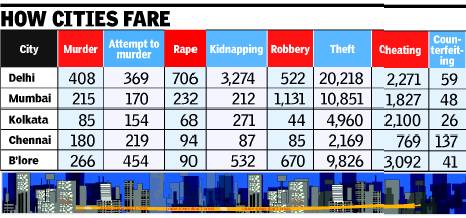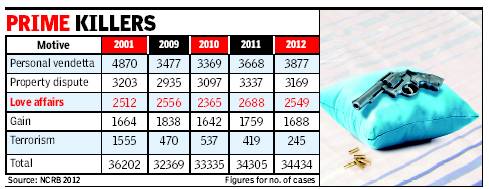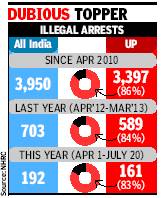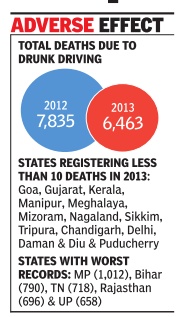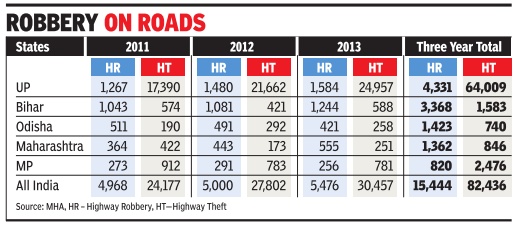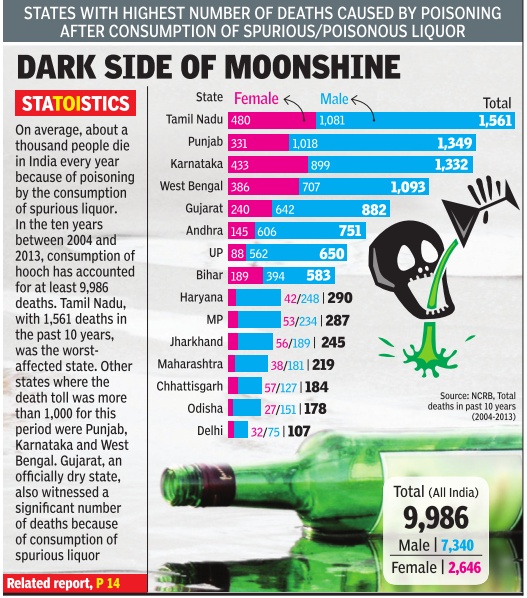Crime: India
(→Illegal arrests) |
(→2014: Accidental gunfire killed more people than terrorists) |
||
| Line 192: | Line 192: | ||
More people died in accidental gunfire in 2014 than in terrorist attacks or Maoist violence. While 561 people (including security forces and terrorists) died in various terror and Maoist-related incidents across the country, 633 died from accidental gunfire. Curiously, close to 50% of these cases happened in UP alone. MP accounted for about 18% of such incidents while Chhattisgarh had 11% fat alities of all deaths due to accidental gunfire. According the three states together accounted for close to 80% of to NCRB data, the three states together accounted for close to 80% of all such deaths. Police sources explained the difference in fatality in accidental gunfire and terror-related incidents to the sheer number of guns in the country. “Private gun licenses run into several lakhs. Even if there is a 0.1% probability of accidental gunfire, it would weigh more than the few hundred terrorists who enter the country with a purpose to kill,“ said an officer with a central force. As far as UP is concerned, police sources attributed the high number of fatal gunfire accidents in the state to its prevalent gun culture and the propensity of its people to randomly fire during social events. | More people died in accidental gunfire in 2014 than in terrorist attacks or Maoist violence. While 561 people (including security forces and terrorists) died in various terror and Maoist-related incidents across the country, 633 died from accidental gunfire. Curiously, close to 50% of these cases happened in UP alone. MP accounted for about 18% of such incidents while Chhattisgarh had 11% fat alities of all deaths due to accidental gunfire. According the three states together accounted for close to 80% of to NCRB data, the three states together accounted for close to 80% of all such deaths. Police sources explained the difference in fatality in accidental gunfire and terror-related incidents to the sheer number of guns in the country. “Private gun licenses run into several lakhs. Even if there is a 0.1% probability of accidental gunfire, it would weigh more than the few hundred terrorists who enter the country with a purpose to kill,“ said an officer with a central force. As far as UP is concerned, police sources attributed the high number of fatal gunfire accidents in the state to its prevalent gun culture and the propensity of its people to randomly fire during social events. | ||
| + | |||
| + | ==2014: Crime against minors== | ||
| + | [http://epaperbeta.timesofindia.com/Article.aspx?eid=31808&articlexml=Crimes-against-minors-Maha-in-bottom-five-20082015014017 ''The Times of India''], Aug 20 2015 | ||
| + | |||
| + | V Narayan | ||
| + | |||
| + | ''' Crimes against minors: Maharashtra in bottom five ''' | ||
| + | |||
| + | Cases of infanticide doubled in Maharashtra, complaints of rape of minors rose by 10.9% and kidnapping of children jumped by almost a thousand cases (54%) in 2014 from the year before, shows the latest National Crime Records Bureau (NCRB) report released on Tuesday . Cases of abandonment of children dipped by 13% in the state but were still the highest in the country. | ||
| + | The only bright spot: cases of foeticide dropped by 59% from 17 in 2013 to 7 the next year. Yet Maharashtra stayed fifth on the list of worst states in India on that count. | ||
| + | |||
| + | Children, the numbers suggest, are at high risk in the state. Experts blamed growing urbanization that is dis mantling old support systems for the rise in crime. “Apart from urbanization, it is the animal instincts in the accused that lead to targeting of minors as they are easy prey and will not be in a position to protest,“ said Dr Suleman Merchant, dean of Sion Hospital. | ||
| + | |||
| + | Psychiatrist Harish Shetty agreed. Children fall among the most vulnerable sections and cannot defend themselves. “They are objects for kidnapping and blackmail where financial gains can be huge. Moreover, children, particularly those unattended, become relatively invisible in a fast-paced world. The invisibility makes them prone to atrocities, crime and exploitation,“ said Shetty . | ||
| + | |||
| + | ==2014: Crime against women== | ||
| + | [http://epaperbeta.timesofindia.com/Article.aspx?eid=31808&articlexml=Bengal-record-of-womens-safety-worst-20082015014020 ''The Times of India''], Aug 20 2015 | ||
| + | |||
| + | Dwaipayan Ghosh | ||
| + | |||
| + | ''' Bengal record of women's safety worst ''' | ||
| + | |||
| + | It was in 2004 that Bengal had perched itself on the top half of the list of crimes against women. Ten years have passed in between but the state has failed to shed its `unsafe' tag. | ||
| + | The NCRB data shows Bengal is still among the worst five performers as far as molestation, domestic violence, kidnapping of girls and human trafficking are concerned. Rape cases have declined, but the state still poses a threat to women, and is safer only than UP. | ||
| + | |||
| + | Police brass claimed awareness has increased and they are focused on their `commitment' towards women safety , but women organizations have a different story to tell. They attribute the rise in attack to political ineptitude and the general sense of lawlessness. | ||
| + | |||
| + | The findings show Kolkata has emerged a better performer but there are still certain specific crimes, like voyeurism and stalking, where the city continues to register cases on a par with Delhi. | ||
Revision as of 16:20, 21 August 2015
This is a collection of newspaper articles selected for the excellence of their content. |
Contents |
2012: Crime in India's 5 biggest cities
Delhi’s dubious distinction: Maximum murders
NCRB Report For 2012 Reveals That 408 People, Double The Figure In Mumbai, Murdered In City
Dwaipayan Ghosh TNN 2013/06/14
New Delhi: The National Crime Records Bureau (NCRB) report for 2012 has confirmed the notion that it is still some time before Delhi can shed its ‘crime capital’ tag. Though the city showed some promise—doing much better than earlier years in containing street crime—the total number of grievous cases registered last year show that only robust policing can bring down crime. An analysis with other cities perhaps explains Delhi’s own set of problems.
According to the NCRB data, 408 murders took place in Delhi last year—highest among 88 cities—while there were only 215 murders in Mumbai, 180 in Chennai and 85 in Kolkata. However, Delhi Police claimed street crime was down, pointing out that Mumbai registered 29 dacoity and 1131 robbery cases while the capital recorded just 13 dacoity and 522 robberies in the same time. Similarly, though there were 369 instances of attempt to murder in the city —higher than 170 registered in Mumbai and 154 in Kolkata—it is Bangalore with 454 which tops the city table.
Certain crimes in Delhi are at least 10 times more than the other cities. Take kidnapping and abduction cases. While Delhi has registered 3274 registered cases, the next city to even come near this figure is Bangalore with 532 cases. Delhi Police though dismiss this as a “wrong analysis”. An officer explained: “We register a kidnapping case when any minor girl goes missing under directions of the court. Show me another city which does this.”
An interesting figure highlighted in the NCRB data is that a total of 20,99,170 complaints were received in Delhi in writing and on phone, including helplines, the most important one being 100. Yet, only a fraction, 60,397, was converted into cases. The corresponding figure for Maharashtra is 94,3994 and about 3,33,680 were turned into complaints.
Cops say NCRB has “confused” normal PCR calls with genuine distress calls. “Our PCR nerve centre receives over 50,000 calls a day. Will you count complaint of power failure or information sought on DTC routes as a genuine complaint?” asked a bemused cop. But then again, while the Maharashtra police took suo moto cognizance in 77,3376 cases, Delhi Police took suo moto cognizance in 13,318 cases.
In a reply to a question by BJP MLA Sahib Singh Chauhan (No. 237) about the total number of incidents of kidnapping, rape and dacoity in the city in the past 10 years, the Delhi government had stated that “bad and perfunctory investigation” along with “noncollection of scientific evidence during the course of investigation” were reasons behind the low conviction rate (around 30 per cent) in these heinous crimes.
“The large expansion of new colonies like Dwarka and Rohini and thousands of unplanned colonies is a critical crimogenic factor, particularly in respect of street crimes like robberies and snatching,” the written answer had said. The fact that most murders in the past three years have been reported from the border districts (268 of 521), the observation makes sense.
The cops list a number of new initiatives, including. a web-based information system for history-sheeters and a fingerprint bank of over 2.25 lakh criminals.
2012: Motives for crime
Statistics show love is the most potent killer
Bharti Jain, TNN | Sep 15, 2013
NEW DELHI: Love is what makes life worth living but, if the latest crime statistics are anything to go by; it remains a potent killer in India. While love affairs and sexual relations were the third most common cause for murders in the country in 2012 — after personal vendetta and property disputes — they accounted for most murders in seven states, including Andhra Pradesh, Uttar Pradesh, Maharashtra and Punjab.
According to the crime data for 2012 — released by the National Crime Records Bureau (NCRB) — personal enmity was behind 3,877 of the 13,448 murders, where the figures clearly identify the motives (with the rest of the total 34,434 murders attributed simply to 'other causes'). Property disputes were the reason for 3,169 murders and love affairs and sexual relations led to 2,549 killings across the country.
The state-wise data is even more interesting. In what could make Cupid squirm, romantic liaisons surpassed personal vendetta and property disputes as the single biggest motive behind murders in Andhra Pradesh (445 murders), UP (325), Maharashtra (254), Punjab (83), Jammu & Kashmir (11), Himachal Pradesh (10) and Nagaland (2). The number of people killed for love in Tamil Nadu was 291, Gujarat (116) and Delhi (54) and was almost equal to murders caused by vendetta or property matters.
Haryana, infamous for honour killings, does not figure among the states where love is the biggest killer. As compared to 50 such killings, personal vendetta accounted for 218 murders.
The 'low scorers' were Kerala (3) and most of the north-eastern states. Love-driven murders were also significantly lower in Rajasthan and West Bengal (39 each) as compared to those arising out of vendetta and property disputes.
There are other revelations in the NCRB data on causes and motives of murders in 2012, which mostly stick to the trends seen since 2001. Bihar accounted for most murders over property disputes last year, which at 1,159 are nearly 36.6% of such killings across the country and 32.5% of the total murders in the state. Bihar recorded the highest murders over personal vendetta (570) and was next only to UP in terms of total murders. While UP recorded 4,966 murders last year, Bihar ranked second with 3,566 murders.
Assam recorded the highest murders due to casteist motives (41), accounting for 56% of the total murders in this category.
Dowry had its most victims in Odisha and West Bengal, claiming 415 and 252 lives, respectively. Andhra Pradesh (167), Maharashtra (130) and Bihar (102) also scored high on dowry deaths. Interestingly, a look at data since 2001 shows a sharp rise in dowry murders from 968 in 2001 to 1,339 in 2011 and 1,458 in 2012.
For those who thought witchcraft was an evil of yore, the 119 deaths it caused nationally in 2012 convey the stark reality. Most witchcraft murders were recorded in Odisha (32), followed by Jharkhand (26), Andhra Pradesh (24) and Bihar (13). The all-India figure in 2012 is much lower than the 240 recorded in 2011 or 126 in 2001.
Political motives claimed 120 lives across the country. No prizes for guessing that Bihar outperformed other states with 32 political murders. While Madhya Pradesh follows next with 28 such murders, West Bengal accounted 22. Political murders in 2012 were less than the 240 recorded in 2011 and 174 in 2001. The sharp decline is largely due to the fall in political killings in Andhra Pradesh from 39 in 2001 and 33 in 2011 to just 2 last year.
Illegal arrests
UP accounts for over 80% of illegal arrests in India
Ahead Of No. 2 Delhi By 3,000%
Deeptiman Tiwary TNN
New Delhi: Uttar Pradesh’s high-handedness is not just reflected in the arbitrary transfer of officers such as Durga Sakthi Nagpal and slapping of bogus cases against dissenters (as in the case of Dalit scholar Kanwal Bharti), it can also be seen in the massive number of illegal arrests made by the UP police.
According to National Human Rights Commission data, UP records an overwhelming majority of illegal arrests in the country, accounting for more than 80% of all such cases. In fact, it tips its nearest competitor, Delhi, by over3,000% almost year after year.
In the past three years (April 2010 to July 2013), UP accounted for 3,397 illegal arrests out of 3,950 such cases recorded across India by NHRC. The count for the rest of the 27 states and seven union territories put together was just 553.
“What do you expect from a state where many politicians themselves are criminals? How do you expect them to have any respect for law and order or human rights?” says Colin Gonsalves of Human Rights Law Network.
From April 2012 to March 2013, NHRC recorded 703 cases of illegal arrests in all. As many as 589 of these were against the UP police. UP accounts for 161 of 192 illegal arrests in ’13
Its closest rivals in this dubious distinction, Uttarakhand and Delhi, were way behind with 14 cases each. Data for this period shows only two other states where the number of illegal arrests had crossed double figures — Karnataka (12) and Andhra Pradesh (10).
In 2013 too (April 1 to July 20), UP accounted for 161 such cases of the total of 192 recorded by NHRC in the entire country. Its closest rival, Delhi, was again was behind with only five cases.
Year 2011 was the worse for UP, with the state police being at the wrong end of the law 1,101 times of the total of 1,249 cases registered by NHRC. Delhi again took the second spot with 38 cases. In 2010 too UP recorded 1,546 such cases of the total of 1,716. These are cases that were brought to NHRC’s notice. The real figures for both UP and other states are bound to be higher as many complainants go to state human rights commissions instead of knocking at NHRC’s doors.
Conversely, sources say, UP being closer to Delhi, more people may tend to approach NHRC in the capital. But if that was true, neighbouring Haryana would also show a high number of illegal arrests. However,Haryana’s figures for many years have remained in single digits.
Illegal weapons: India
2012-June 2015: Illegal weapons seized

Violent crimes 2012
Violent crimes highest in UP in 2012
In violent crimes, UP tops list: National Crime Research Bureau
Isha Jain, TNN | Jun 22, 2013
LUCKNOW: The annual report of National Crime Research Bureau (NCRB) has revealed that Uttar Pradesh tops the list of states in terms of murders. Also, UP has earned the credit for maximum number of kidnappings, dowry related deaths and robberies in the year 2012. (Editor: UP is the most populous state of India. Hence absolute numbers do not convey the true picture. A better yardstick would be ‘violent crimes per 1,000 of population.’)
Not only this, but UP has for the third consecutive year retained its top position in violent crimes. The state reported a total of 33,824 incidents in 2012. This included 4,966 murders, 8,878 kidnappings, 3,159 robberies, 2,244 dowry deaths along with other major crimes, according to NCRB. In 2010, UP accorded 27,225 cases of violent crimes followed by 32,987 in 2011.
NCRB data revealed that it is not [a] specific age group which is committing crimes. Rather, people from all age groups are indulging in it. In 2012 alone, 10.7% of the total crimes were committed by people of above 50 years. Those between 18-30 years committed 46% crime. As high as 15% of the total offenders were women.
Social activists say that present situation of increasing crime is worrisome. "There is no stringent punishment for the criminals. As a result, they walk freely with head high on the streets," said an activist.
Drunk-driving deaths: 2013
Drunk-driving deaths show sharp decline
Dipak Dash New Delhi:
The Times of India Sep 01 2014
But Cops' False Reporting May Be Real Reason
States known for their high consumption of liquor have reported less road deaths caused due to driving under influence of alcohol. Goa, Kerala, Sikkim and Tripura reported only one fatality each while Bengal, Manipur, Dadra & Nagar Haveli, Daman & Diu, Lakshadweep and Puducherry registered no death due to drunk driving in 2013.
Six other states and UTs including Delhi and Gujarat reported less than 10 deaths. The data is encouraging at a time when India is struggling to reduce its road fatalities. According to the latest road accident report of the road transport ministry , the number of accidents caused due to driving under influence of al cohol and drugs decreased to 20,290 in 2012 from 23,979 the previous year. Total deaths decreased significantly to 6,463 last year from 7,835 in 2012.
The big change is primarily on account of UP and Jharkhand witnessing sharp drop in fatalities due to drunk driving. The data shows that though UP topped the list in total fatalities last year, it saw fewer deaths attributed to drunk driving.About 658 died in such accidents in 2013 against 2,414 the previous year. In case of Jharkhand, such deaths fell to 241 in 2013 compared to 438 in 2012.
States that saw significant increase in such deaths included Madhya Pradesh, Rajasthan and Jammu & Kashmir.
Delhi did not see any change, though the city police have intensified their crackdown. According to government data, six people died in such accidents last year the same as the year before.
While the decline in drunk driving deaths may be a positive sign, questions have been raised whether police “honestly“ record the cause of death in such cases. This is because cops often do not show a victim killed in a road accident as “under influence of alcohol“ so that his family can get the insurance claim.
Highway crimes: 2011-13
UP, Bihar top in highway crimes; Goa, J&K safest
Deeptiman Tiwary New Delhi:
The Times of India Sep 01 2014
You are most likely to be waylaid, robbed or become a victim of theft if you are driving on a national highway through Uttar Pradesh or Bihar. However, if you are crossing Goa, terror-infested Jammu & Kashmir or the insurgency-affected northeast, you are most likely to reach your destination safe and sound.
Government data on highway crimes show it is most dangerous to drive through UP and Bihar with both states registering highest number of highway robberies in the past three years. The two states together account for almost 50% of all highway robberies in the country .
At third, fourth and fifth are Odisha, Maharashtra and Madhya Pradesh accounting for around 18% of all robberies on the highway .
In the category of theft on highways, however, UP tops the chart by a huge margin. Of the over 82,000 cases of theft across the country on highways in the past three years, UP accounted for over 64,000 (almost 80%). Here too, Bihar is placed second but with just over 1,500 cases.
Experts cite a slew of factors leading to crimes on highways. Since both Uttar Pradesh and Bihar already have very high incidence of crime, it is natural it would be reflected on the highways. Secondly , for most states, maintaining day-to-day law and order within towns and cities takes priority over securing highways which suffer from lack of enough personnel and vehicles for highway patrol. Not far from Delhi, parts of highways in western UP are regularly shut off by UP police and traffic diverted through sleeping towns as they are unable to ensure safety along deserted stretches.
Goa has turned out to be the best state in terms of threat of highway robberies recording merely nine robberies in three years. The figure for thefts too is barely in double digits.
Deaths from poisonous liquor: 2004-13
Hoax calls: 2012- 2014
The Times of India Dec 22 2014
Hoax calls of bomb threats at railway stations and airports hugely inconvenience both public and police. The reply to a recent Parliament question stated that there is no specific state-wise record maintained of such calls.The data collated to answer the particular question on prank calls regarding railways and airports shows that in the past three years, Maharashtra police received 66 such calls regarding railways the highest in the country. For the same period, Tamil Nadu police received four such misleading calls about Chennai airport -higher than other airports.
2014

2014: Accidental gunfire killed more people than terrorists
The Times of India, July 26, 2015
Deeptiman Tiwary
More people died in accidental gunfire in 2014 than in terrorist attacks or Maoist violence. While 561 people (including security forces and terrorists) died in various terror and Maoist-related incidents across the country, 633 died from accidental gunfire. Curiously, close to 50% of these cases happened in UP alone. MP accounted for about 18% of such incidents while Chhattisgarh had 11% fat alities of all deaths due to accidental gunfire. According the three states together accounted for close to 80% of to NCRB data, the three states together accounted for close to 80% of all such deaths. Police sources explained the difference in fatality in accidental gunfire and terror-related incidents to the sheer number of guns in the country. “Private gun licenses run into several lakhs. Even if there is a 0.1% probability of accidental gunfire, it would weigh more than the few hundred terrorists who enter the country with a purpose to kill,“ said an officer with a central force. As far as UP is concerned, police sources attributed the high number of fatal gunfire accidents in the state to its prevalent gun culture and the propensity of its people to randomly fire during social events.
2014: Crime against minors
The Times of India, Aug 20 2015
V Narayan
Crimes against minors: Maharashtra in bottom five
Cases of infanticide doubled in Maharashtra, complaints of rape of minors rose by 10.9% and kidnapping of children jumped by almost a thousand cases (54%) in 2014 from the year before, shows the latest National Crime Records Bureau (NCRB) report released on Tuesday . Cases of abandonment of children dipped by 13% in the state but were still the highest in the country. The only bright spot: cases of foeticide dropped by 59% from 17 in 2013 to 7 the next year. Yet Maharashtra stayed fifth on the list of worst states in India on that count.
Children, the numbers suggest, are at high risk in the state. Experts blamed growing urbanization that is dis mantling old support systems for the rise in crime. “Apart from urbanization, it is the animal instincts in the accused that lead to targeting of minors as they are easy prey and will not be in a position to protest,“ said Dr Suleman Merchant, dean of Sion Hospital.
Psychiatrist Harish Shetty agreed. Children fall among the most vulnerable sections and cannot defend themselves. “They are objects for kidnapping and blackmail where financial gains can be huge. Moreover, children, particularly those unattended, become relatively invisible in a fast-paced world. The invisibility makes them prone to atrocities, crime and exploitation,“ said Shetty .
2014: Crime against women
The Times of India, Aug 20 2015
Dwaipayan Ghosh
Bengal record of women's safety worst
It was in 2004 that Bengal had perched itself on the top half of the list of crimes against women. Ten years have passed in between but the state has failed to shed its `unsafe' tag. The NCRB data shows Bengal is still among the worst five performers as far as molestation, domestic violence, kidnapping of girls and human trafficking are concerned. Rape cases have declined, but the state still poses a threat to women, and is safer only than UP.
Police brass claimed awareness has increased and they are focused on their `commitment' towards women safety , but women organizations have a different story to tell. They attribute the rise in attack to political ineptitude and the general sense of lawlessness.
The findings show Kolkata has emerged a better performer but there are still certain specific crimes, like voyeurism and stalking, where the city continues to register cases on a par with Delhi.
